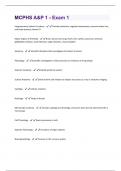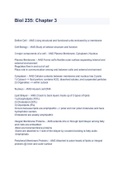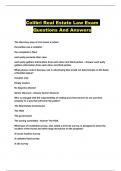MCPHS A&P 1 - Exam 1
Integumentary System Functions - Provide protection, regulate temperature, prevents water loss,
and helps produce vitamin D
Major Organs of the Body - Brain, spinal cord, lung, heart, liver, spleen, pancreas, stomach,
gallbladder, kidneys, small intestine, large intestine, urinary bladder
Anatomy - Scientific discipline that investigates the body's structure
Physiology - Scientific investigation of the processes or functions of living things
Systemic Anatomy - Studied system by system
Surface Anatomy - External form and relation to deeper structures as x-ray in anatomic imaging
Cytology - Cellular anatomy
Histology - Study of tissues
Microscopic anatomy - Includes cytology and histology; structures that must be examined with a
microscope
Cell Physiology - Exams processes in cells
Systemic Physiology - Functions of organ systems
Nuerophysiology - Focuses on the nervous system
,Cardiovascular Physiology - The heart and blood vessels
Pathology - Structural and functional changes caused by disease
Exercise Physiology - Changes in structure and function caused by exercise
Chemical Level - Interaction of atoms
Cell Level - Structural and functional unit of living organisms
Tissue Level - Group of similar cells and the materials surrounding them
Organ Level - One or more tissues functioning together
Organ System Level - Group of organs functioning together
Organism level - Any Living Thing
Structural and Functional Organization of the Human Body - atoms -> molecules -> cell -> tissue ->
organ -> organ system -> organism
Integumentary System - Consists of skin, hair, nails, and sweat glands
Skeletal System Functions - Provides protection and support, allows body movements, produces
blood cells, and stores minerals and fats
Skeletal System - Consists of bones, associated cartilages, ligaments, and joints
,Muscular System Functions - Produces body movements, maintains posture, and produces body
heat
Muscular System - Consists of muscles attached to the skeleton by tendons
Lymphatic System Functions - Removes foreign substances from the blood and lymph, combats
disease, maintains tissue fluid balance, and absorbs fats from the digestive tract
Lymphatic System - Consists of the lymphatic vessels, lymph nodes, and other lymphatic organs
Respiratory System Functions - Consists of the lungs and respiratory passages
Respiratory System - Consists of the lungs and respiratory passages
Digestive System Functions - Performs the mechanical and chemical processes of digestion,
absorption of nutrients, and elimination of wastes
Digestive System - Consists of the mouth, esophagus, stomach, intestines, and accessory organ
Nervous System Functions - A major regulatory system that detects sensations and controls
movements, physiological processes, and intellectual functions
Nervous System - Consists of the brain, spinal cord, nerves, and sensory receptors
Endocrine System Functions - A major regulatory system that influences metabolism, growth,
reproduction, and many other functions
Endocrine System - Consists of glands, such as the pituitary, that secrete hormones
, Cardiovascular System Functions - Transports nutrients, waste products, gases, and hormones
throughout the body; plays a role in the immune response and regulation of body temperature
Cardiovascular System - Consists of the heart, blood vessels, and blood
Urinary System Functions - Remove waste products from the blood and regulates blood pH, ion
balance, and water
Urinary System - Consists of the kidneys, urinary bladder, and ducts that carry urine
Female Reproductive System Functions - Produces oocytes and is the site of fertilization and fetal
development; produces milk for newborn; produces hormones that influence sexual function and
behaviors
Female Reproductive System - Consists of ovaries, vagina, uterus, mammary glands, and
associated structures
Male Reproductive System Functions - Produces and transfers sperm cells to the female and
produces hormones that influence sexual functions and behaviors
Male Reproductive System - Consists of the testes, accessory structures, ducts, and penis
Characteristics of Life - Organization, Metabolism, Responsiveness, Growth, Development,
Differentiation, Morphogenesis, Reproduction
Organization - Condition in which there are specific relationships and functions
Metabolism - All chemical reactions of the body
Responsiveness - Abiilty to sense changes and adjust






